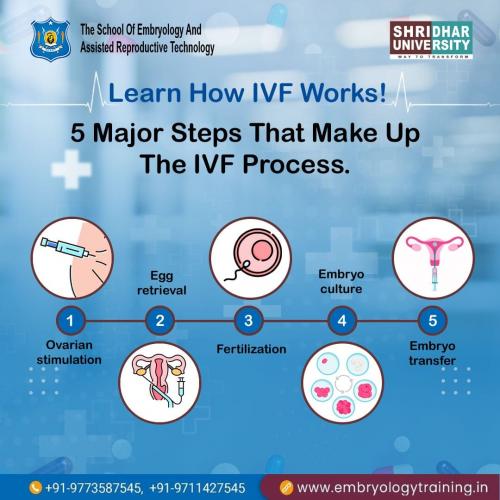5 Major steps that make up the IVF process

In the realm of assisted reproductive technology, In-Vitro Fertilization (IVF) stands as a beacon of hope for countless couples struggling with infertility. It's a complex and fascinating journey that involves several intricate steps, each playing a pivotal role in the quest to bring new life into the world. In this article, we'll dive deep into the IVF process, breaking it down into five major steps. So, let's embark on this enlightening journey into the world of IVF.
1. Ovarian Stimulation: The Prelude to IVF Success
Imagine your ovaries as the treasure trove of potential life. In the first step of the IVF process, known as ovarian stimulation, we aim to maximize this potential. It's like preparing the soil before planting seeds. Fertility medications, often administered in the form of injections, are used to stimulate the ovaries to produce multiple eggs. The goal is to have more eggs available for fertilization, increasing the chances of success.
1.1 Monitoring and Hormone Testing
Throughout the ovarian stimulation phase, regular monitoring through ultrasounds and hormone testing is crucial. This helps the medical team track the growth and maturation of the eggs. Adjustments to medication doses might be made based on these assessments, ensuring optimal conditions for egg retrieval.
2. Egg Retrieval: The Harvesting of Precious Eggs
Once the eggs are ripe for retrieval, it's time for a minor surgical procedure known as egg retrieval. This step is often performed under light anesthesia, ensuring comfort for the patient. A thin needle is used to extract the mature eggs from the ovaries. It's a critical step in the IVF process, as the quality and quantity of eggs retrieved greatly influence the chances of success.
2.1 Laboratory Handling and Storage
Immediately after retrieval, the eggs are carefully handled and preserved in a controlled environment. This is where advanced techniques and equipment, such as those offered by SEART, come into play. Proper handling is essential to maintain the viability of the eggs.
3. Fertilization: Where Magic Happens
With the eggs in safe custody, it's time for the magic to happen – fertilization. In the conventional IVF method, sperm from the partner or a donor is combined with the eggs in a laboratory dish. This dish is carefully monitored, and the embryologists watch for signs of successful fertilization.
3.1 Intracytoplasmic Sperm Injection (ICSI)
In some cases where there are concerns about the sperm's ability to fertilize the egg, a technique called ICSI is used. This involves injecting a single sperm directly into the egg. It's like giving a little nudge to nature to ensure fertilization occurs.
4. Embryo Culture: Nurturing the Future
Once fertilization takes place, the resulting embryos need a safe and nurturing environment to grow. They are placed in a special incubator where conditions mimic those inside the female body. This step, known as embryo culture, can take a few days, during which the embryos develop and reach a stage where they are ready for transfer.
4.1 Blastocyst Culture
For some patients, embryos are cultured for a longer period, allowing them to develop into blastocysts. Blastocyst transfer can have advantages, as it helps in selecting the most viable embryos for transfer, increasing the chances of a successful pregnancy.
5. Embryo Transfer: The Culmination of Efforts
Finally, we reach the climax of the IVF journey – embryo transfer. This is the moment when one or more selected embryos are carefully placed into the uterus, with the hope that they will implant and develop into a healthy pregnancy. It's like planting the seedling in fertile soil, nurturing the potential for new life.
5.1 Embryo Quality Assessment
Before transfer, the embryologists, often armed with cutting-edge technology like SEART's embryology training solutions, assess the quality of the embryos. This helps in selecting the best candidates for transfer, increasing the chances of a successful outcome.
In conclusion, the IVF process is a remarkable journey that involves these five major steps – ovarian stimulation, egg retrieval, fertilization, embryo culture, and embryo transfer. Each step is crucial, and advancements in technology, like those offered by SEART, play a pivotal role in improving success rates. Through these steps, the dreams of parenthood become attainable for many, bringing joy and hope to countless families worldwide.
Advertise on APSense
This advertising space is available.
Post Your Ad Here
Post Your Ad Here
Comments